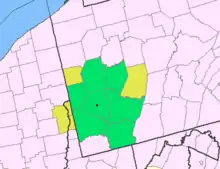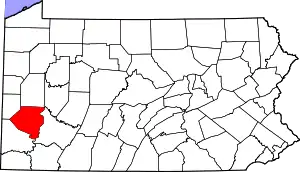Sewickley Hills, Pennsylvania
Sewickley Hills is a borough in Allegheny County, Pennsylvania, United States. The population was 639 at the 2010 census.[3]
Sewickley Hills, Pennsylvania | |
|---|---|
 Houses on Henry Road | |
 Location in Allegheny County and the U.S. state of Pennsylvania. | |
| Coordinates: 40°33′38″N 80°7′12″W | |
| Country | United States |
| State | Pennsylvania |
| County | Allegheny |
| Government | |
| • Mayor | David Malarik Sr (R) |
| Area | |
| • Total | 2.47 sq mi (6.39 km2) |
| • Land | 2.47 sq mi (6.39 km2) |
| • Water | 0.00 sq mi (0.00 km2) |
| Population (2010) | |
| • Total | 639 |
| • Estimate (2019)[2] | 690 |
| • Density | 279.47/sq mi (107.92/km2) |
| Time zone | UTC-5 (Eastern (EST)) |
| • Summer (DST) | UTC-4 (EDT) |
| FIPS code | 42-69416 |
| Website | www |
Education
Sewickley Hills is served by the Quaker Valley School District.
Taxes
The Quaker Valley SD (shared with twelve other municipalities) mill rate in 2017 was 18.40. This ranked 35th highest/most expensive out of Allegheny County's 45 school districts, between West Allegheny SD (34th highest) and North Allegheny SD (36th highest).[4]
Government and Politics
| Year | Republican | Democratic | Third Parties |
|---|---|---|---|
| 2016 | 55% 224 | 44% 180 | 1% 1 |
| 2012 | 58% 233 | 40% 161 | 2% 5 |
Councilmembers
- [2017-2019] Multiparty-3(Phillips,Guttendorf,Hajnas), Republicans-1(Faulkner), Unknowns-1(Lepone)[7]
Geography
Sewickley Hills is located at 40°33′38″N 80°7′12″W (40.560548, -80.119960).[8]
According to the United States Census Bureau, the borough has a total area of 2.5 square miles (6.5 km2), all land.
Surrounding neighborhoods
Sewickley Hills has five borders, including Bell Acres to the north, Franklin Park to the northeast, Ohio Township to the east, Aleppo Township to the south, and Sewickley Heights to the west.
Demographics
| Historical population | |||
|---|---|---|---|
| Census | Pop. | %± | |
| 1960 | 326 | — | |
| 1970 | 270 | −17.2% | |
| 1980 | 419 | 55.2% | |
| 1990 | 622 | 48.4% | |
| 2000 | 652 | 4.8% | |
| 2010 | 639 | −2.0% | |
| 2019 (est.) | 690 | [2] | 8.0% |
| Sources:[9][10][11][12] | |||
At the 2000 census there were 652 people, 225 households, and 186 families living in the borough. The population density was 261.8 people per square mile (101.1/km²). There were 231 housing units at an average density of 92.8 per square mile (35.8/km²). The racial makeup of the borough was 94.33% White, 2.45% African American, 1.84% Asian, 0.77% from other races, and 0.61% from two or more races. Hispanic or Latino of any race were 1.69%.[11]
There were 225 households, 40.0% had children under the age of 18 living with them, 77.3% were married couples living together, 3.6% had a female householder with no husband present, and 16.9% were non-families. 13.8% of households were made up of individuals, and 6.2% were one person aged 65 or older. The average household size was 2.90 and the average family size was 3.23.
The age distribution was 28.8% under the age of 18, 4.3% from 18 to 24, 25.2% from 25 to 44, 32.8% from 45 to 64, and 8.9% 65 or older. The median age was 40 years. For every 100 females there were 103.1 males. For every 100 females age 18 and over, there were 98.3 males.
The median household income was $79,466 and the median family income was $92,102. Males had a median income of $58,125 versus $31,875 for females. The per capita income for the borough was $38,681. About 3.6% of families and 3.5% of the population were below the poverty line, including 2.2% of those under age 18 and 2.9% of those age 65 or over.
References
- "2019 U.S. Gazetteer Files". United States Census Bureau. Retrieved July 28, 2020.
- "Population and Housing Unit Estimates". United States Census Bureau. May 24, 2020. Retrieved May 27, 2020.
- "Race, Hispanic or Latino, Age, and Housing Occupancy: 2010 Census Redistricting Data (Public Law 94-171) Summary File (QT-PL), Sewickley Hills borough, Pennsylvania". United States Census Bureau. Retrieved September 23, 2011.
- EL. "Allegheny County Treasurer". Retrieved 1 September 2017.
- EL. "2012 Allegheny County election". Pittsburgh Tribune-Review. Retrieved 15 October 2017.
- EL. "2016 Pennsylvania general election results". Pittsburgh Post-Gazette. Retrieved 15 October 2017.
- EL. "Allegheny County". Election Results. Retrieved 2 August 2019.
- "US Gazetteer files: 2010, 2000, and 1990". United States Census Bureau. 2011-02-12. Retrieved 2011-04-23.
- "Number of Inhabitants: Pennsylvania" (PDF). 18th Census of the United States. U.S. Census Bureau. Retrieved 22 November 2013.
- "Pennsylvania: Population and Housing Unit Counts" (PDF). U.S. Census Bureau. Retrieved 22 November 2013.
- "U.S. Census website". United States Census Bureau. Retrieved 2008-01-31.
- "Annual Estimates of the Resident Population". U.S. Census Bureau. Archived from the original on 20 November 2013. Retrieved 22 November 2013.

